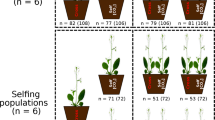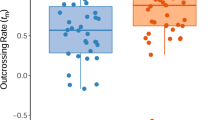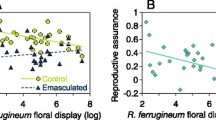Abstract
Selfing can evolve if the transmission advantage of selfers outweighs the negative effects of inbreeding depression. It has been hypothesised that on the long term, selfing lineages are an evolutionary dead end, in part due to genetic degradation resembling that of Muller’s ratchet in asexual lineages. There is a lack of empirical evidence for costs of selfing due to genetic degradation in recently evolved selfers. We tested whether such costs are apparent in recently established selfing populations of the generally outcrossing species Arabidopsis lyrata. Specifically, we compared selfing and outcrossing populations in their growth performance, and for traits that play a putative role in defence against herbivores. In line with our expectations, selfing populations had reduced germination rates, growth however was similar to outcrossing populations. Plants from selfing populations showed no consistent reduction in herbivore-defence traits, and were equally palatable to caterpillars of the moth Mamestra brassicae. There were also no differences between outcrossers and selfers in phenotypic plasticity for putative defence traits and palatability after induction by herbivores. Overall, we interpret our results as showing some evidence for persistent costs of selfing due to drift or inbreeding load in terms of reduced seedling establishment, but providing no support for the hypothesis that selfing populations should be more susceptible to generalist herbivores, or rely more on induced defence.



Similar content being viewed by others
References
Agrawal AA (2000) Benefits and costs of induced plant defense for Lepidium virginicum (Brassicaceae). Ecology 81:1804–1813
Baker HG (1955) Self compatibility and establishment after long distance dispersal. Evolution 9:347–349
Barton NH, Charlesworth B (1998) Why sex and recombination? Science 281:1986–1990
Bates D, Maechler M, Bolker B, Walker S (2014) lme4: linear mixed-effects models using Eigen and S4. R package version 1.1-6. arXiv:1406.5823v1
Burd M (1994) Bateman principle and plant reproduction—the role of pollen limitation in fruit and seed set. Bot Rev 60:83–139
Busch JW (2004) Inbreeding depression in self-incompatible and self-compatible populations of Leavenworthia alabamica. Heredity 94:159–165
Byers DL, Waller DM (1999) Do plant populations purge their genetic load? Effects of population size and mating history on inbreeding depression. Annu Rev Ecol Syst 30:479–513
Campbell SA, Kessler A (2013) Plant mating system transitions drive the macroevolution of defense strategies. Proc Natl Acad Sci USA 110:3973–3978
Charlesworth D, Charlesworth B (1987) Inbreeding depression and its evolutionary consequences. Annu Rev Ecol Syst 18:237–268
Charlesworth D, Morgan MT, Charlesworth B (1990) Inbreeding depression, genetic load, and the evolution of outcrossing rates in a multilocus system with no linkage. Evolution 44:1469–1489
Clauss MJ, Dietel S, Schubert G, Mitchell-Olds T (2006) Glucosinolate and trichome defenses in a natural Arabidopsis lyrata population. J Chem Ecol 32:2351–2373
Darwin C (1876) The effects of cross and self-fertilisation in the vegetable kingdom. John Murray, London
Díaz S, Noy-Meir I, Cabido M (2001) Can grazing response of herbaceous plants be predicted from simple vegetative traits? J Appl Ecol 38:497–508
Falahati-Anbaran M, Lundemo S, Agren J, Stenoien HK (2011) Genetic consequences of seed banks in the perennial herb Arabidopsis lyrata subsp petraea (Brassicaceae). Am J Bot 98:1475–1485
Fisher RA (1941) Average excess and average effect of a gene substitution. Ann Eugen 11:53–63
Foxe JP, Stift M, Tedder A, Haudry A, Wright SI, Mable BK (2010) Reconstructing origins of loss of self-incompatibility and selfing in North American Arabidopsis lyrata: a population genetic context. Evolution 64:3495–3510
Gols R, Wagenaar R, Bukovinszky T, van Dam NM, Dicke M, Bullock JM, Harvey JA (2008) Genetic variation in defense chemistry in wild cabbages affects herbivores and their endoparasitoids. Ecology 89:1616–1626
Hayes CN, Winsor JA, Stephenson AG (2004) Inbreeding influences herbivory in Cucurbita pepo ssp. texana (Cucurbitaceae). Oecologia 140:601–608
Heller R, Maynard-Smith J (1978) Does Muller’s ratchet work with selfing? Genet Res 32:289–293
Hoebe PN, Stift M, Tedder A, Mable BK (2009) Multiple losses of self-incompatibility in North-American Arabidopsis lyrata? phylogeographic context and population genetic consequences. Mol Ecol 18:4924–4939
Hoebe PN, Stift M, Holub EB, Mable BK (2011) The effect of mating system on growth of Arabidopsis lyrata in response to inoculation with the biotrophic parasite Albugo candida. J Evol Biol 24:391–401
Husband BC, Schemske DW (1996) Evolution of the magnitude and timing of inbreeding depression in plants. Evolution 50:54–70
Igic B, Bohs L, Kohn JR (2006) Ancient polymorphism reveals unidirectional breeding system shifts. Proc Natl Acad Sci USA 103:1359–1363
Igic B, Lande R, Kohn JR (2008) Loss of self-incompatibility and its evolutionary consequences. Int J Plant Sci 169:93–104
Ioerger TR, Clark AG, Kao TH (1990) Polymorphism at the self-incompatibility locus in Solanaceae predates speciation. Proc Natl Acad Sci USA 87:9732–9735
Johnson MTJ, Smith SD, Rausher MD (2009) Plant sex and the evolution of plant defenses against herbivores. Proc Natl Acad Sci USA 106:18079–18084
Karkkainen K, Agren J (2002) Genetic basis of trichome production in Arabidopsis lyrata. Hereditas 136:219–226
Kempel A, Schadler M, Chrobock T, Fischer M, van Kleunen M (2011) Tradeoffs associated with constitutive and induced plant resistance against herbivory. Proc Natl Acad Sci USA 108:5685–5689
Kivimaki M, Karkkainen K, Gaudeul M, Loe G, Agren J (2007) Gene, phenotype and function: GLABROUS1 and resistance to herbivory in natural populations of Arabidopsis lyrata. Mol Ecol 16:453–462
Lande R, Schemske DW, Schultz ST (1994) High inbreeding depression, selective interference among loci, and the threshold selfing rate for purging recessive lethal mutations. Evolution 48:965–978
Leimu R, Fischer M (2010) Between-population outbreeding affects plant defence. PLoS One 5:e12614
Leimu R, Kloss L, Fischer M (2008) Effects of experimental inbreeding on herbivore resistance and plant fitness: the role of history of inbreeding, herbivory and abiotic factors. Ecol Lett 11:1101–1110
Levin DA (1975) Pest pressure and recombination systems in plants. Am Nat 109:437–457
Lewis MCF, Karrow PF, Blasco SM, McCarthy FMG, King JW, Moore TC, Rea DK (2008) Evolution of lakes in the Huron basin: deglaciation to present. Aquat Ecosyst Health 11:127–136
Loe G, Torang P, Gaudeul M, Agren J (2007) Trichome production and spatiotemporal variation in herbivory in the perennial herb Arabidopsis lyrata. Oikos 116:134–142
Mable BK, Adam A (2007) Patterns of genetic diversity in outcrossing and selfing populations of Arabidopsis lyrata. Mol Ecol 16:3565–3580
Mable BK, Robertson AV, Dart S, Di Berardo C, Witham L (2005) Breakdown of self-incompatibility in the perennial Arabidopsis lyrata (Brassicaceae) and its genetic consequences. Evolution 59:1437–1448
Muller HJ (1964) The relation of recombination to mutational advance. Mutat Res Fundam Mol Mech Mutagen 1:2–9
Puentes A, Agren J (2013) Trichome production and variation in young plant resistance to the specialist insect herbivore Plutella xylostella among natural populations of Arabidopsis lyrata. Entomol Exp Appl 149:166–176
R Core Team (2014) R: a language and environment for statistical computing. R Foundation for Statistical Computing, Vienna
Ross-Ibarra J, Wright SI, Foxe JP, Kawabe A, DeRose-Wilson L, Gos G, Charlesworth D, Gaut BS (2008) Patterns of polymorphism and demographic history in natural populations of Arabidopsis lyrata. PLoS One 3:e2411
Rutter MT, Shaw FH, Fenster CB (2010) Spontaneous mutation parameters for Arabidopsis thaliana measured in the wild. Evolution 64:1825–1835
Shaw RG, Byers DL, Darmo E (2000) Spontaneous mutational effects on reproductive traits of Arabidopsis thaliana. Genetics 155:369–378
Sicard A, Lenhard M (2011) The selfing syndrome: a model for studying the genetic and evolutionary basis of morphological adaptation in plants. Ann Bot 107:1433–1443
Sletvold N, Huttunen P, Handley R, Karkkainen K, Agren J (2010) Cost of trichome production and resistance to a specialist insect herbivore in Arabidopsis lyrata. Evol Ecol 24:1307–1319
Sletvold N, Mousset M, Hagenblad J, Hansson B, Agren J (2013) Strong inbreeding depression in two Scandinavian populations of the self-incompatible perennial herb Arabidopsis lyrata. Evolution 67:2876–2888
Stebbins GL (1957) Self fertilization and population variability in the higher plants. Am Nat 91:337–354
Stephenson AG, Leyshon B, Travers SE, Hayes CN, Winsor JA (2004) Interrelationships among inbreeding, herbivory, and disease on reproduction in a wild gourd. Ecology 85:3023–3034
Stift M, Hunter BD, Shaw B, Adam A, Hoebe PN, Mable BK (2013) Inbreeding depression in self-incompatible North-American Arabidopsis lyrata: disentangling genomic and S-locus-specific genetic load. Heredity 110:19–28
Takebayashi N, Morrell PL (2001) Is self-fertilization an evolutionary dead end? Revisiting an old hypothesis with genetic theories and a macroevolutionary approach. Am J Bot 88:1143–1150
van Leur H, Vet LE, van der Putten WH, van Dam NM (2008) Barbarea vulgaris glucosinolate phenotypes differentially affect performance and preference of two different species of lepidopteran herbivores. J Chem Ecol 34:121–131
Vergeer P, Kunin WE (2011) Life history variation in Arabidopsis lyrata across its range: effects of climate, population size and herbivory. Oikos 120:979–990
Willi Y (2013) Mutational meltdown in selfing Arabidopsis lyrata. Evolution 67:806–815
Wright SI, Nano N, Foxe JP, Dar V-U (2008) Effective population size and tests of neutrality at cytoplasmic genes in Arabidopsis. Genet Res 90:119–128
Wright SI, Kalisz S, Slotte T (2013) Evolutionary consequences of self-fertilization in plants. Proc R Soc B 280:20130133
Zuur A, Ieno EN, Walker N, Saveliev AA, Smith GM (2009) Mixed effects models and extensions in ecology with R. Springer, New York
Acknowledgments
We thank Barbara Mable for kindly providing the seeds that formed the basis of this experiment, Wayne Dawson for statistical advice, Christine Giele, Katya Mamonova and Carolin Bogs for practical assistance, the gardeners for their help with plant maintenance, Anne Kempel for discussion, Leon Westerd for providing caterpillar eggs and Gerald Mende and Dieter Schopper for use of the animal rearing facilities and practical advice; four anonymous reviewers and the editor for their constructive comments on the manuscript.
Author information
Authors and Affiliations
Corresponding author
Ethics declarations
Conflict of interest
The authors declare no conflicts of interest.
Electronic supplementary material
Below is the link to the electronic supplementary material.
Rights and permissions
About this article
Cite this article
Joschinski, J., van Kleunen, M. & Stift, M. Costs associated with the evolution of selfing in North American populations of Arabidopsis lyrata?. Evol Ecol 29, 749–764 (2015). https://doi.org/10.1007/s10682-015-9786-3
Received:
Accepted:
Published:
Issue Date:
DOI: https://doi.org/10.1007/s10682-015-9786-3




